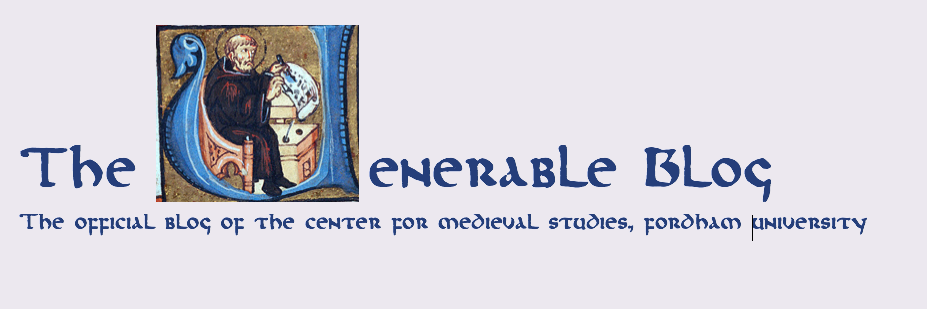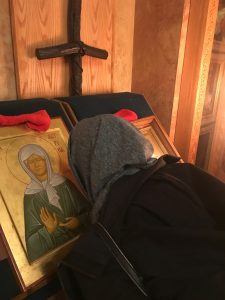 On April 1st of this year, approximately 1.2 billion people celebrated Easter in the Catholic Church. Seven days later, approximately 225 – 300 million people celebrated Easter in the Eastern Orthodox Church. The date of Easter differs because of the observance of two different calendars: the Gregorian in the West and the Julian in the East. I was raised in a Catholic household, but much of my family kept their Eastern Slavic traditions, which sparked my curiosity to celebrate Easter in an Eastern and a Western church this year. The two churches split in 1054 due to several theological disagreements, including the use of the word filioque in the Creed. The Eastern church did not support the change which articulated the procession of the Holy Spirit from the Father and the Son. Additionally, the Eastern church resented the Western insistence on clerical celibacy and use of unleavened bread in the Eucharist. By celebrating Easter in both of these traditions, I was able to experience firsthand these differing traditions. Each paschal celebration exhibited the legacy of the theologies behind the 1054 schism, into the twenty-first century.
On April 1st of this year, approximately 1.2 billion people celebrated Easter in the Catholic Church. Seven days later, approximately 225 – 300 million people celebrated Easter in the Eastern Orthodox Church. The date of Easter differs because of the observance of two different calendars: the Gregorian in the West and the Julian in the East. I was raised in a Catholic household, but much of my family kept their Eastern Slavic traditions, which sparked my curiosity to celebrate Easter in an Eastern and a Western church this year. The two churches split in 1054 due to several theological disagreements, including the use of the word filioque in the Creed. The Eastern church did not support the change which articulated the procession of the Holy Spirit from the Father and the Son. Additionally, the Eastern church resented the Western insistence on clerical celibacy and use of unleavened bread in the Eucharist. By celebrating Easter in both of these traditions, I was able to experience firsthand these differing traditions. Each paschal celebration exhibited the legacy of the theologies behind the 1054 schism, into the twenty-first century.
I first attended liturgy at St. Thomas the Apostle Byzantine Catholic Church in Rahway, NJ. Many of my family members are Byzantine Catholic, and I was very familiar with the liturgy and the Easter traditions. The liturgy began with an exclamation of the paschal greeting “Христос Воскрес” (Christos voskres, “Christ is Risen”), to which the congregation replied “Воистину Воскрес” (Voistinu voskres, “Risen indeed”). We celebrated the liturgy of St. John Chrysostom, the most common liturgy in the Byzantine and Eastern churches, which unfolded as usual with a few exceptions. For example, the Troparion (a short hymn sung throughout the liturgy) throughout the liturgy was “Христось воскресе из мертвыхъ, смертью смерть поправ и пребывающим во гробах жизнь даровав” meaning, “Christ is risen from the dead, trampling down death by death, and to those in the tombs he granted life.” The selected readings were Acts 1:1-8 (The Promise of the Holy Spirit and the Ascension of Jesus), and John 1:1-17 (The Word Became Flesh). These readings were done in English, but the Gospel reading was read line by line, alternating between English and Old Church Slavonic. After the Gospel reading, the celebrants prepared the gifts for the Eucharist at the altar behind the open iconostasis, a screen of icons separating the altar from the space occupied by the laity. Leavened bread is submerged in the chalice of wine and the faithful approach the priest, who then raises a spoon containing the blessed sacraments to the lips of the faithful to consume. Before receiving the Eucharist, the priest asks my name then says, “Katherine, servant of God, receives the precious and all holy and most pure Body and Blood of our Lord and God, Jesus Christ for the remission of her sins and for life everlasting.” After the Eucharistic celebration, the dismissal was also out of the ordinary. Instead of the clergy exiting immediately, the priest anointed each individual in the congregation with holy oil. The priest said “Christos voskres” before anointing my forehead with the 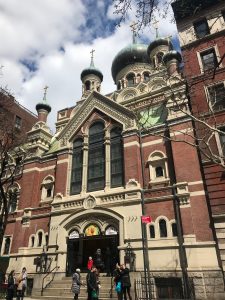 sign of the cross while I responded “Voistinu voskres.” This continued until everyone had been anointed and the church slowly cleared out into a reception hall for the blessing of baskets.
sign of the cross while I responded “Voistinu voskres.” This continued until everyone had been anointed and the church slowly cleared out into a reception hall for the blessing of baskets.
The following week, I celebrated the Liturgy of the Divine Resurrection of Christ at St. Nicholas Russian Orthodox Cathedral in New York City, and the experience was enthralling from beginning to end. Approaching the cathedral from the East, you can catch a glimpse of the onion domes through the New York City skyscrapers.
Upon entering the church, a few things stand out immediately: The cathedral is spacious, exemplified by the absence of pews. Icons occupy much of the wall space, and devotional candles are lit before them. All of the women wore headscarves. But most prominently, the iconostasis separates the altar space and the space occupied by the laity.
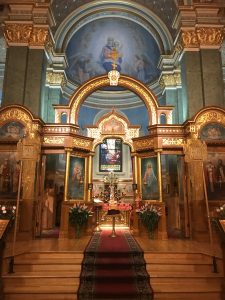
Before the celebration, the laity moved through the Cathedral lighting candles and kissing icons. The liturgy began with an outburst of angelic music as the choir was situated in a balcony above the congregation. Bells rang as two clergy members censed the entire space, starting at the altar and then moving around the periphery to cense each icon.
At St. Nicholas, we also celebrated the Divine Liturgy of St. John Chrysostom; however, the liturgy was celebrated in Old Church Slavonic. Given my lack of familiarity with the language, I did some prep work, rehearsing the Creed and the Our Father. I also brought a liturgical booklet to follow along with the liturgy, with side-by-side Old Church Slavonic and English. And I am pleased with how well I was able to follow along! The liturgy unfolded as expected, and I participated as often as I could in Old Church Slavonic. Like the Byzantine tradition, the call and response of “Christos voskres” and “Voistinu voskres” frequently occurred. When it came time for the celebration of the Eucharist, I took a few steps back to observe, as I am unable to participate in this sacrament in the Orthodox Church, but from what I could see, the customs were like those in the Byzantine rite. However, one thing set apart the two Eucharistic celebrations, given the open floor of the Orthodox Cathedral: to receive the Eucharist, the laity had to move towards one of the three celebrants who were distributing the sacrament. The process was not orderly and there was a lot of crowding, but the nature of the situation felt more authentic. As opposed to waiting in line, the faithful approached the sacrament in a crowd, each individual longing for his or her chance to receive the body and blood of Christ.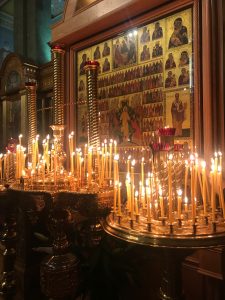
The liturgy concluded shortly after, but many did not leave the church. People brought out loaves of bread, what I grew up calling paska, and placed a candle into the loaf. The bread symbolizes Jesus Christ; the candle represents Him as the light of the world. This is a tradition my family still holds dear, and I was ecstatic when I saw it practiced at the end of the liturgy. As the loaves of bread were brought out, one of the celebrants came towards the congregation to bless the breads, baskets, and faithful with holy water. Unlike anything I had ever experienced in the Roman rite, the aspergillum used to sprinkle the holy water resembled a brush. The bristles absorb the water, and the priest again calls out three times “Christos voskres” as he sprinkles douses the faithful with holy water as they thrice reply “Voistinu voskres.” I wandered the cathedral to venerate the icons, kissing each one. I even lit a candle before the icon of St. Sergius of Radonezh (a 14th century monastic saint), and every few minutes there would be another blessing with holy water. This was a unifying experience because after the liturgy worshipers went their separate ways in the church to venerate different icons and pray before the iconostasis, but when the paschal greeting was called, everyone joined in response. I made my way around the cathedral and eventually decided it was time for me to leave, but as I was leaving, others were entering, as the paschal celebrations continued throughout the entire day.
Reflecting on the two liturgical experiences, I see many similarities, beginning with their structure. Both the Byzantine rite and the Russian Orthodox celebrated the liturgy of St. John Chrysostom, so the celebrations very closely mirrored each other. Though the Orthodox liturgy was in Old Church Slavonic, given my familiarity with this liturgical tradition, I was able to follow along for much of the celebration. There were however subtle differences such as the Byzantine praying for the Pope, and the Orthodox instead praying for the Patriarch and Metropolitan. Interaction with icons was more prominent in the Orthodox tradition, and truly made the experience mystical. Though these two traditions have their differences, at the end of the day, each liturgy was celebrating the same thing… Christos voskres!
